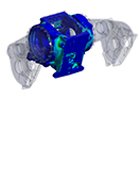
 |
Simulate the mechanical behavior of materials in real-world conditions
ANSYS Mechanical Pro adds more features to the capabilities of ANSYS DesignSpace. It has the same user interface as DesignSpace, resulting in a fast learning experience and greater productivity for regular or occasional users.
|
|
Contact capabilities
ANSYS Mechanical Pro includes a comprehensive range of contact capabilities that enable you to account for the interactions of multiple parts. It can simulate everything from a bonded contact that treats joints between parts as if they are glued or welded together, to contact interfaces that allow parts to move apart and together with or without frictional effects. Being able to simulate contact correctly means that you can simulate the change in load paths when parts deform and confidently predict how assemblies will behave in the real world.
Fatigue analysis
Being able to understand the immediate stresses and deformations a part undergoes is critical to structural analysis. Any part undergoing repeated loading may accumulate damage that will eventually result in part failure even though the loading is not close to the limits of the material. Fatigue analysis enables visualization of life and damage during cyclic loading and can help to predict where failure may occur and increase product durability.
Large deflection
Analysis of geometric nonlinearities caused by large deflections means that much more accuracy can be accounted for due to effects such a stress stiffening. Linear assumptions during structural analysis could lead to inaccuracies.
|
Capabilities
High-Performance ComputingContact detection, mesh generation and solving operations all benefit from additional, ever-increasing core counts. Distributed ANSYS solutions can increase speed in applications that use up to 1,000 cores.
 |
Geometric NonlinearityCapture the change in stiffness caused by loads applied to structures, ensuring your simulation accounts for effects like stress stiffening, large strain and large deflections.
 |
Fatigue ModuleAvoid failure due to repeated cyclic loading. Fatigue analysis can determine the capability of a material to survive the loading cycles experienced during its lifetime.
 |
Contact CapabilitiesSimulate contacts or joints in assemblies. Model frictional, bonded and other types of contacts with automatic contact generation to accelerate the creation of contact pairs.
 |
MultiphysicsAnalyze the interaction of different physics phenomena to better simulate real-world conditions. Example interactions: Fluid-Structure interaction (one-way) Thermal-Structure interaction (sequential). Other interactions through external data.
 |
Thermal AnalysisPerform steady-state and transient thermal analyses of products, including conduction, convection and radiation effects. Modeling phase-change and temperature-dependent materials ensures an accurate simulation.
 |
